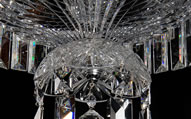![]()
The correct chandelier in your entrance hall will create a welcomed atmosphere while providing you with the general light you need to greet your guests, and assure a safe welcome into your home. If your entrance hall is an extra large area, you may also want to add wall lights. Wall lights should be installed 60 inches from the floor and be 6 foot 8 inches apart.
Chandeliers are designed to float in a room as an important part of the decor. Too large and this fixture will overpower the space. Too small and it will look out of place. To determine the proper sized chandelier for a room or entrance hall, add the dimensions together
Example: A 12 foot x 16 foot room.
Add the two together to get 28 foot. ( 12 + 16 = 28 )The proper sized chandelier would then be 28 inches in diameter.Make sure the bottom of the chandelier does not hang any lower than 7 foot for a foyer/entrance hall or 6 foot 6 inches for a room.
Tips
Click on each of the headings below for more information:



